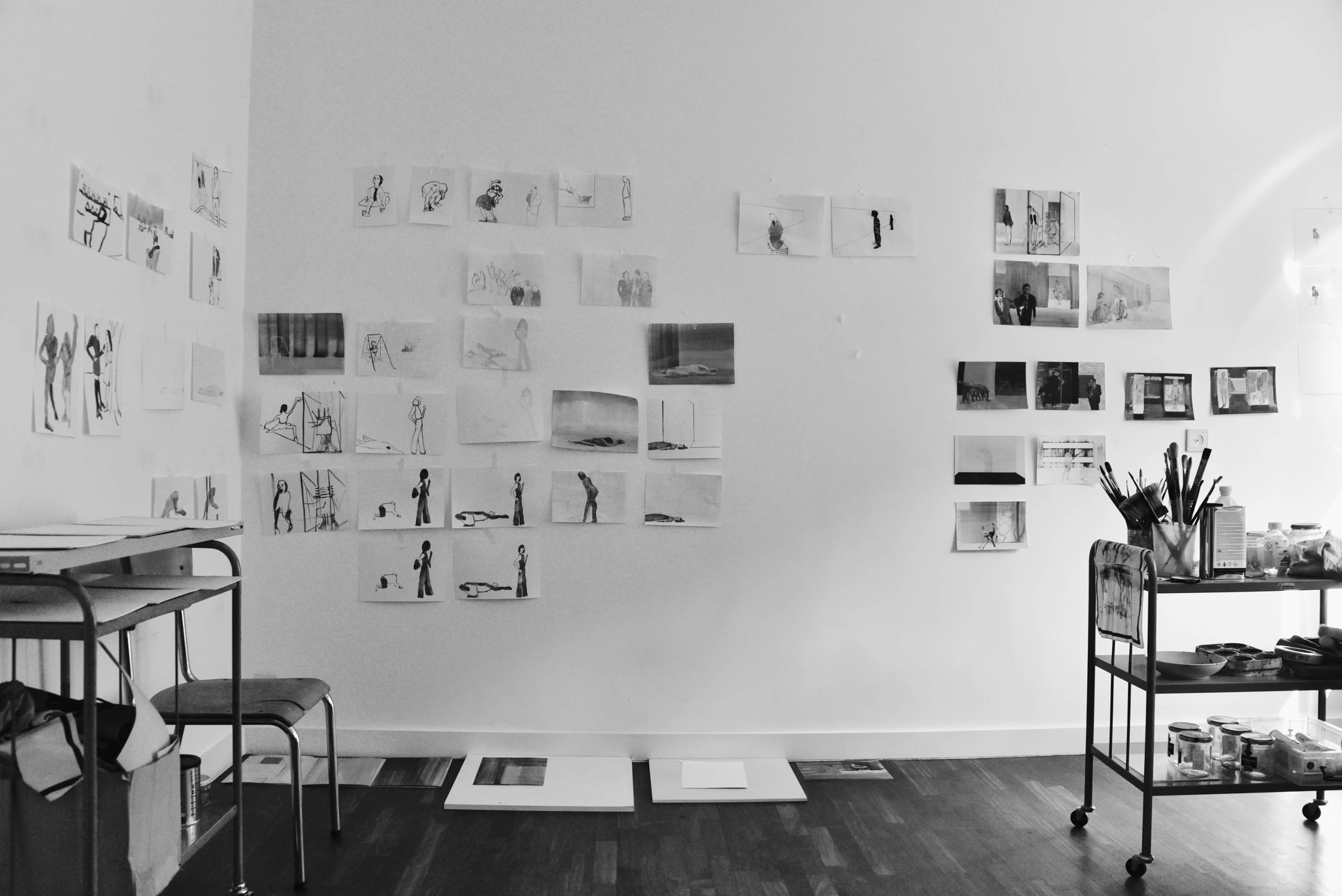
Texts
Laurence Baud’huin, Mélissa Ansel Space, 2022
One step back two steps forward
By bringing together Jana Phlips, Emma Shoring and Tim Trenson, Melissa Ansel Gallery invites these three artists to a dance. The steps are known. The rhythm is set. The choreography, however, belongs to them: each one glides along the dance floor with their own pictorial universe, references and emotions.
One step back, two steps forward. Jana Phlips takes the creative impetus in hindsight, with humility that leads her to fully reveal her process, research and materials: cardboard, plaster and concrete, usually relegated to sketches or mould, are here sublimated, exposed for themselves. Like life, the work is fragile, messy, challenging. One step back, two steps forward. Emma Shoringworks with layers, literally and figuratively. If femininity as traditionally represented is her starting point – the step back is then a step into historicity – her work only takes shape because it resonates with previous reflections. Side steps that allow for the sensual swaying, the swaying, the organicity of the painting.
One step back, two steps forward. Perhaps Tim Trenson came up with this title because, like his work, it is imbued with a certain pragmatism tinged with humour, with an efficiency that explodes, with the idea of erasure, of repentance. “I have to kill my babies to bring the composition into being”, he would say. Thus, Tim Trenson’s paintings show absence as much as presence and reveal a perceptible spiral process of creation, an assumed trial and error.
Hélène Jacques, L’Orangerie Bastogne, 2019
Petites histoires et discrétions - Emma Shoring et Marie Zolamian
Cette année, le programme de la saison se concentre sur les médiums de la peinture et du dessin. Un choix et une mise à l’honneur peu anodins qui méritent réflexion et questionnement. Comment ces médiums ont-ils évolué dans le paradigme de l’art contemporain ? Doit-on percevoir par ce choix une réaction à une certaine vision éclatée de l’art actuel ou au frénétisme de la société aujourd’hui? L’Orangerie nous prouve par cette saison 2019 que ces médiums restent profondément pertinents. Les différents duos d’artistes invités se répondent si bien qu’il peut être difficile de les décerner. La première exposition, Petites histoires et discrétions, présente deux regards sur l’intimité, sur des histoires personnelles, une relation artiste - modèle, des voyages, de l’inconnu, des traces de l’atelier. Le spectateur y découvre différentes couches de sens dans les travaux présentés : réaction aux médias, au journalisme, à l’image et au portrait dans les médias, mais aussi un regard sur un monde multiple, difficile à cerner, impliquant des connexions sociales voire une certaine hybridation socio- culturelle.
Le travail d’Emma Shoring reflète une approche fine et subtile sur ces questionnements, ainsi qu’une réflexion sur les genres, sur les différences entre les hommes et femmes, parfois d’un autre temps peu lointain. Elle s’approprie des images de magazines simulant un monde de bonheur, qui expriment un certain malaise sociétal, de l’hypocrisie, de l’arrogance et soulève les questions de genre. Hommage à Matisse dénote un certain regard fin sur les corps des femmes dans une ambiance idyllique de bord de mer. Ces corps sont à ce point esquissés qu’ils en deviennent abstraits, ils se détachent de la personne, de son être, du modèle et devient une forme perdue dans un espace doux et indéfini. Ces corps féminins sont ici réappropriés par une artiste femme. A l’inverse avec Peintures de P.E., Shoring invite un ami à poser dans son atelier. Une nouvelle relation artiste - modèle est alors mise en jeu. Très vite, un écart se crée entre les esquisses en jaune et noir, et le modèle. Ce dernier se transforme ainsi en silhouette anonyme tout comme les femmes de Matisse dans le paysage balnéaire.
Marie Zolamian, quant à elle, explore la mémoire individuelle et collective, fluide et hybride, construite dans un espace-temps multiple. Elle parle d’exil, d’auto-déracinement, d’identité, de tradition, de collectivité. Son travail se situe entre narratif autobiographique et autofiction. Son exploration se base sur des images tirées d’internet, peut-être même de google street view, puis s’élabore comme un voyage imaginé, non loin en Belgique. Ces narratifs se définissent-ils comme un besoin d’appropriation de l’espace habité ? Il en ressort des images qui témoignent d’une mémoire collective que l’on s’approprie, qui permettent de compléter notre propre mémoire individuelle. Marie Zolamian présente des objets et des portraits sur fond sombre, sans contexte ni spatialisation, ramenant le motif au plus près du spectateur. Placés en évidence, ces portraits, par leur très grande présence, contrastent très fort avec les silhouettes esquissées de Hommage à Matisse de Shoring. Cette absence de contexte serait-elle signe de cette expérimentation de l’auto-déracinement ? Ou d’une volonté d’abstraction de l’objet, vers une expérience plus universelle ?
Le petit format induit une intimité et entraîne une proximité du spectateur à l’œuvre. Un certain nombre des travaux qui semblent relever de la recherche en atelier sont exposés. Cette présentation offre le potentiel d’une perception au plus proche de la création et du processus artistique. Le titre de l’exposition n’annonce pas de suite toutes les couches de significations. L’exposition est à mûrir et à méditer. Le pertinent jeu de dialogue amène une dimension différente aux travaux et à la pratique de chacune. Avec une grande délicatesse et subtilité, les deux artistes présentent un travail profondément actuel, contemporain, engagé dans des questions sociétales. A travers leur pratique et leurs recherches, la peinture et le dessin s’en voient pertinemment actuels.
Virginie Devillers, January 2017
Beautiful and vulnerable. The paintings of Emma Shoring
A large and light room. Unfinished works fixed on white walls : drawings, watercolours. Piles of magazines, selected and classified images on a table. Books. I haven’t seen Emma Shoring’s work since Precious and Polite at Quartiers Latins (Brussels 2011). She then showed fine and delicate miniature portraits of women. I also remember very scenographical and colourful figurative compositions.
Small sketchlike scenes. A dog moves towards us. He holds himself in a cage or in a forest of vertical lines. A woman’s body focused on a danse or gymnastics movement. A clothed man in physical exertion. The figures sometimes reappear in other scenes. Their gestures seized, in abeyance. The pictures are composed of a few guidelines and coloured areas (Sans titre, 2016). The paint is very present, raw, arid. It seems, something, dramatically, may occur. But what ?
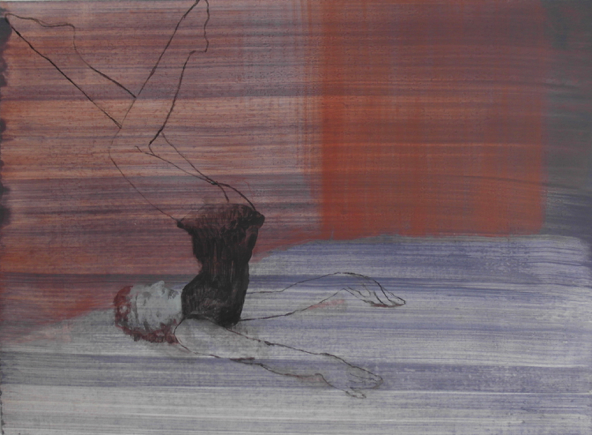 Ca-h022, 2016
Ca-h022, 2016
Very different from the small portraits of attired, undressed or naked women (In front of the mirror, 2004). They hold themselves face on, sideways, sometimes framed close-up. Their flesh is pinkish, pearly. The paint almost transparent. Watercolour highlights underline a breast areola, a hand outline, an armfold, a shoulderstrap, a red coat. At times they question our gaze, or is it their own reflection they’re scrutinizing in the mirror? They are enticing but not beautiful. That is what they would like to be. It’s their sole enterprise. A certain awkwardness of shape contradicts the affectation of the figure. Could there be beauty in gracelessness ?
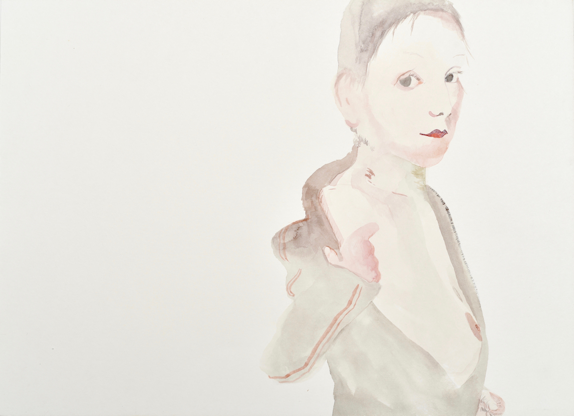 Mir-10, 2004
Mir-10, 2004
To the question What interests you in painting ? the artist replies : « I’m interested in codes. The archetypes one tries to conform with. The codes a woman takes on, to be looked at and desired. The signs she invests to conform with what is expected of her ? ». So these women are looking at themselves, looking at us and are perhaps waiting for our approval. She also talks of skin tone, gaze, visual pleasure, archetype, tragi-comedy. She mentions ancient masters, Francisco de Goya, Francesco Guardi, Diego Velasquez. And also Francis Bacon, Hans Bellmer, Cindy Sherman. The difficulty for a painting to resist through time by the necessary and the perdurable mental activation induced by the composition, the play of colours.
The feminine archetypes and codes can also be found in two series of oil paintings (Points of view, 2006- and Models of women, 2008-2010). In the first, the artist uses celebrity photographs, selected for their sharpness. The smiles are forced, artificial, as often in fashion magazine photography. The women are there to seduce, observing themselves being observed. They appear as masks of representation. In the other series, the medium close-up framed models pose against a uniform background. One can feel the importance of the poise, the attention and care gone into the outfit. Make-up, evening dress, hairstyle, jewels, fur. In both series, the paint blurs faces and bodies. The social codes are distorted. No longer precious and privileged, just the portraits of fake women in representation of themselves.
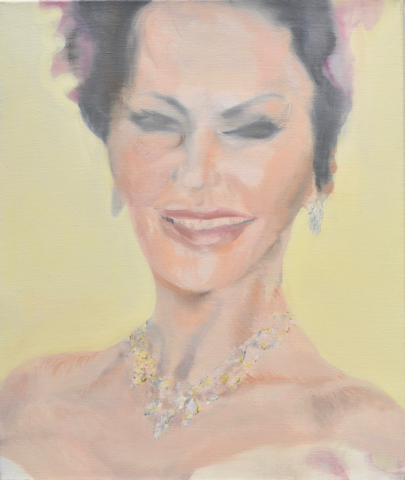 PV-h02, 2006
PV-h02, 2006
In 2003, the artist paints four portraits of friends in their personal environment (Portraits of women series, oil on canvas, 2003). She did not pursue this work and confides being disappointed with the results. The close and direct contact with the model seems to have impeded her to burden the image with that something different, that shifts it elsewhere. In these more classical portraits, I notice the elegance of pose, the strength of gesture and expression. All is there, in front of our eyes. No off-screen, no mental space. Nothing really disturbs the aloofness of these women frozen in their attitudes. « I like the meaning of a painting to be unclear ».
To grasp the significance of this thought, I go back to two former series. The first dates from 1999 Dormant situations, the other from 2002 Nude. Large oil paintings on canvas (150x170 cm and 100x120 cm). Strong and contrasted colours. Very photographic. The Dormant situations series are based on failed photographs. Photographs taken by the artist, the ones which don’t find their place in the family album because they’re out of focus, badly framed, the protagonists are not at their best. These photographs, she says, reveal our unconscious attitudes that escape inadvertently our vigilance for others to see. Transposed to the pictorial space as genre paintings in which we are able to recognize uncontrolled images of ourselves.
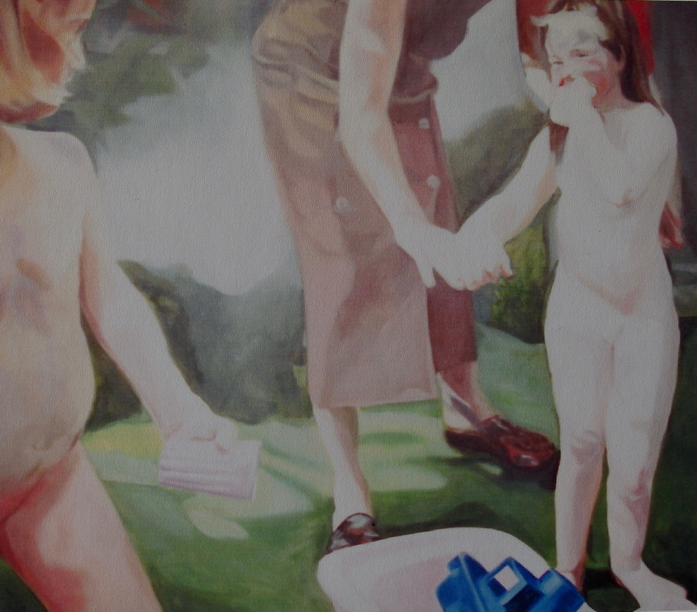 The incident, two girls, 1999
The incident, two girls, 1999
A summer afternoon for example. Perhaps a tea party with friends. Little girls of around four maybe five years old. They’re naked. And hold themselves on each side of the composition. It feels as if the first will enter or leave the pictorial space. The white plump body of the second solidly standing on the green grass faces her. Toys placed between the two are perhaps the reason of a mishap (The incident, two little girls, 1999). The one with long dark hair, hand in mouth, grasps the arm of a woman who leans towards her no doubt to console her. Entirely within her gesture, the woman has no face. She is a body bending towards the child. The intangible gaze exchanged between the two girls travels through the picture, bringing to the scene mystery and dramatic intensity.
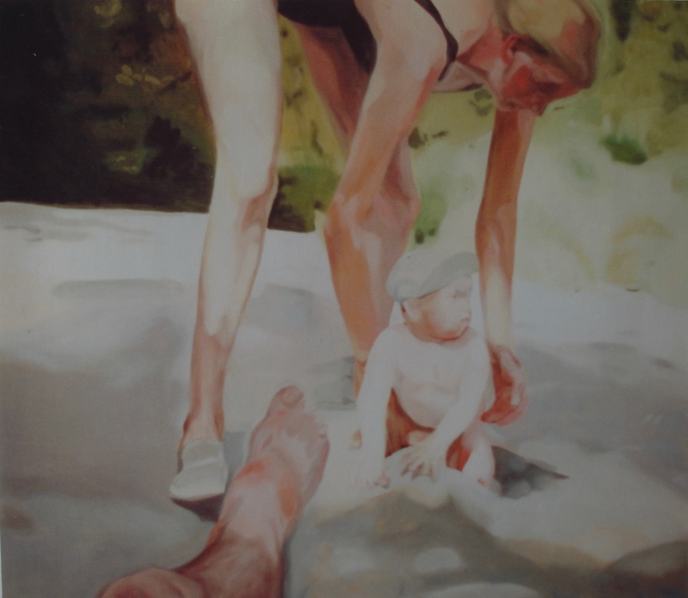 An afternoon by the river, 1999
An afternoon by the river, 1999
An afternoon by the river (1999) also figures a mother’s gesture towards her child. Her body is cut up, fragmented. In the foreground, a leg, odd and tense so close to the mother and child, breaks into the frame, connecting and disturbing the image.
A woman wearing a long blue dress in a light walled room. She comes forward. No face. Is she screaming ? She seems on the point of toppling over, of falling out of the picture. Towards us. Behind, chidren’s toys, a little boy on a bike (The game, 1999). These accessories stabilize the unstable composition. I think of the artist’s recent paintings. There is always a tense suspended moment, a sketched and depersonnified body on the move – the absence of a face.
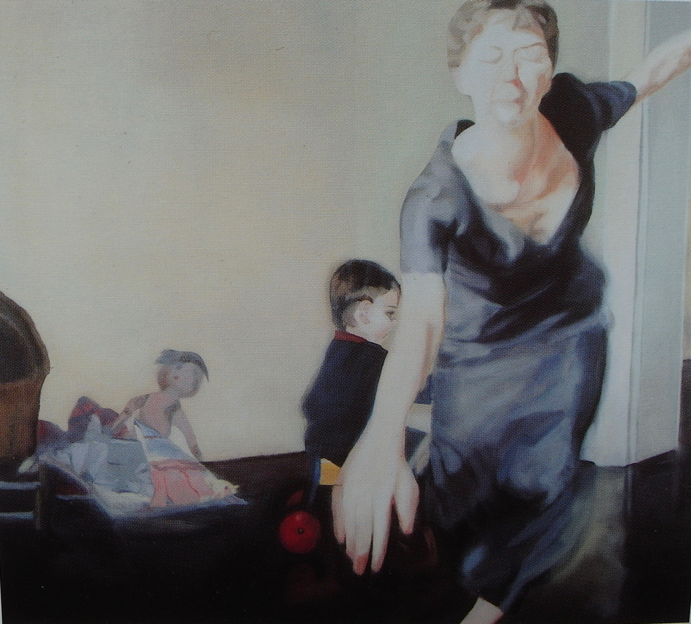 The game, 1999
The game, 1999
In former pictures, the paintings often focus on a chubby faced baby whose mouth stretches towards the viewer hinting a kiss (Say hello, 1999) or on the face of a middle-aged woman (The guests 3, 1998). In these two pictures, the paint seems thick, the colours strong, measured, contrasted. The woman has a ruddy complexion and grey teeth (The guests 3). She has too much make-up on and addresses a smile to the onlooker and doesn’t see the considerate and smiling presence of the man behind her who perhaps is her husband. A commonplace scene. The last moments of an opening or reception ?
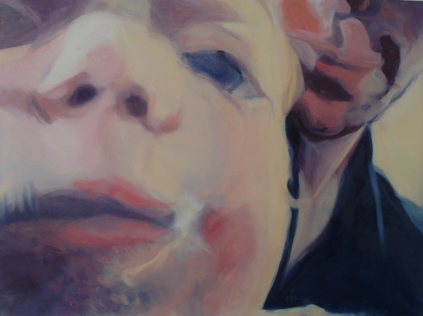 Say hello, 1999
Say hello, 1999
 The guests 3, 1998
The guests 3, 1998
The two paintings of the series Nude (2002) are from a low angle shot. The onlooker is entirely taken by the clouds (The cliff) and the intense blue of the sky (Seaside). The presence of figures (a child, woman, sleeping man) seem to depict a waking dream. Beyond the dreamlike even surreal dimension of this series, we are invited to leave the frame, eyes closed and imagine what is at stake beyond the representation.
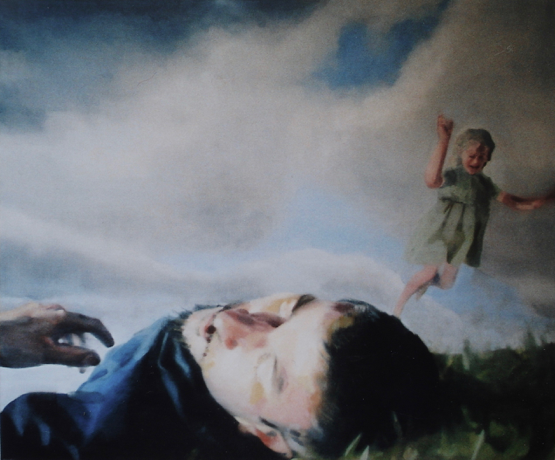 The cliff, 2002
The cliff, 2002
 At the seaside, 2002
At the seaside, 2002
Certain works of ancient masters move her deeply. She mentions ‘The parlour of the Nuns at San Zaccaria’ by the Venitian Francesco Guardi (XVVIII century), exhibited today at the Ca’Rezzonica in Venice. The landscape layout, the hierarchical construction of the room (the sacred and profane areas materialized by the parlour railings, the children’s puppet theater…), the theatrical lighting, the white dress of the person in the center who holds herself majestically like a virginal light, create a dramatic, almost erotic tension enhanced by the ultra codified scene and symbolic load built within. She talks about the mental and narrative construction that one finds in certain paintings from the past that nourish her work. « I am passionate about ancient art, how I am taken by the painting, almost trapped and discover little by little what’s held within. The pictorial signs become visible, like reading a book. The fragmented lecture enables me to travel from one area to another and regenerates my understanding of the painting. »
When she doesn’t start from pre-existing images transposed into painting, the brush then guides her into what occurs, between good luck and waste, requiring discernement. A supposition when discovering her current work. Exists also the sensual pleasure in painting a landscape, a scene drenched with sunlight, a movement, a gesture, a body. Thus moments of contemplation expand time and are sometimes the premises to future compositions.
Desire as the origin. Aroused by a mental or pre-existing image chosen for what it reveals, for what it yields to the present. The visible must also be honored, and in the case of a portrait, the person represented. Is painting also an act of love ? The love of a curve, fold, colour, face, the sway of a contained or unfurled body, fragile, beautiful and vulnerable.
L’arrière-pays des créateurs – composed by Virginie Devillers. Revue de l’ULB. Edition Complexe, 2003
An attempt at appropriation. Emma Shoring
The inside is porous of the outside. The world burrows in the folds of my brain. Things descend through bones into flesh and connect with what is there. More or less. Sometimes the folds are ample and ancestral, so things fall. And are difficult to catch. They lie waiting.
I am lived in.
The world is inside and outside. Of uneven density. Images invent themselves. My continuous adjustments relieve the pressure. Swallow the stones and drink the explosions. To be oneself when I am him. To be myself when I am her. Carry the things. Become the object of oneself and surrender. A delight!
Yet I am alone in my body. It’s silent resistance insidiously reminds me of my violence. Don’t come too close. Listen to it breathing. But, you know, threat can also be fictional.
Oblivion is frightening.
Véronique Depiesse - 1999
Emma Shoring’s latest paintings, W.D’Huysser Gallery
I observe us. I weigh the air between us where our feelings are diffracted. What are you thinking about? I look at you, yet I know it’s not you I see. Something always eludes. The world is but a copy of an unfathomable elsewhere. Your familiar sihouette, movements, features remain entirely mysterious. And when in your arms, surreptitious expressions and attitudes are spilled almost inadvertantly. You’re both playing in the garden and I’m moving around you. Behind the lens, my anonymous eye at the edge of the perceptible gathers without effort unflattering images. I dont quite know what I’m looking at. Is it the space shuffled by our bodies, the air our mouths have grasped and expelled, heavy with our profound exhalations ? Choices, chances, feelings that pervade us, redefine and constrain us. I want to catch and draw the thread. Uncover the origins and widen the possibilities. I summon the images of our bodies to submit to our phantasies. Almost unaware, I delineate the blunders and after effects. I seize the most familiar revealed as a worrying strangeness within an obscure permanence and refutation. And intensify it into an imaginary field. The I-they-you-us dance is awkward and many comments are to be made. With an ear glued to life and an eye open elsewhere, I carefully watch us in a dream, petrified in an irreversable chain. And my memory is a dazzled compilation of all these minute dissimulations and unexpressed audacities.